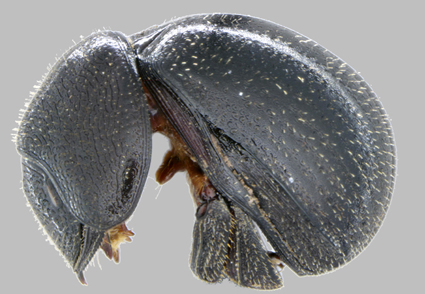Abstract
This study targets two specimens of a morphologically highly unusual pill scarab from Cameroon. The original morphology-inspired hypothesis that these beetles represent a new genus is refuted. Instead, a phylogenetic analysis of 90 terminals and 3231 aligned DNA positions linked both specimens with the Afrotropical genus Melanophilharmostes Paulian, 1968. Both Cameroonian specimens are herein described as Melanophilharmostes tuber Grebennikov, new species. Re-evaluation of the morphological characters of this species in light of molecular results corroborated this taxonomic decision by detecting all three morphological autapomorphies of the genus: the presence of setae and horseshoe-shaped microsculpture on the dorsal body surface, as well as the presence of the lateral carina on each elytron. Except for a single representative of the genus Melanophilharmostes placed within the genus Pseudopterorthochaetes Paulian, 1977 (interpreted as an analytical artifact), both genera are sister groups, in agreement with the pre-existing morphology-based hypothesis. Both genera, together with the Malagasy/Comorian genus Synarmostes Germar, 1843 and monotypic Balleriodes Grebennikov, 2021 from Tanzania, constitute the strongly supported Synarmostes group of genera.
References
Ballerio, A. (2016) A first phylogenetic appraisal of two allied genera of Afrotropical Ceratocanthinae: Melanophilharmostes and Pseudopterorthochaetes (Coleoptera: Hybosoridae). Fragmenta entomologica, 48, 33–52. https://doi.org/10.4081/fe.2016.159
Ballerio, A. (2021) The Ceratocanthinae of Madagascar and Comoro Islands: a revision of the genera Synarmostes and Goudotostes, and of the flightless Philharmostes, with description of 64 new species (Coleoptera: Scarabaeoidea, Hybosoridae). Fragmenta entomologica, 53, 105–282. https://doi.org/10.13133/2284-4880/545
Ballerio, A., Gill, B.D. & Grebennikov, V.V. (2011) Illustrated overview and identification key to Cameroonian Ceratocanthinae beetles (Coleoptera: Scarabaeoidea: Hybosoridae) with description of four new species. Zootaxa, 2892 (1), 1–24. https://doi.org/10.11646/zootaxa.2892.1.1
Ballerio, A. & Grebennikov, V.V. (2016) Rolling into a ball: phylogeny of the Ceratocanthinae (Coleoptera: Hybosoridae) inferred from adult morphology and origin of a unique body enrollment coaptation in terrestrial arthropods. Arthropod Systematics and Phylogeny, 74, 23–52.
DiGirolomo, M.F., Jendek, E., Grebennikov, V.V. & Nakladal, O. (2019) First North American record of an unnamed West Palaearctic Agrilus (Coleoptera: Buprestidae) infesting European beech (Fagus sylvatica) in New York City, USA. European Journal of Entomology, 116, 244–252. https://doi.org/10.14411/eje.2019.028
Grebennikov, V.V. (2017) Phylogeography and sister group of Lupangus, a new genus for three new flightless allopatric forest litter weevils endemic to the Eastern Arc Mountains, Tanzania (Coleoptera: Curculionidae, Molytinae). Fragmenta entomologica, 49, 37–55. https://doi.org/10.4081/fe.2017.229
Grebennikov, V.V. (2019a) First DNA analysis of pill scarabs (Coleoptera: Hybosoridae: Ceratocanthinae) reveals multiple paraphyly of Afrotropical Philharmostes and detects its basal dichotomy formed by a new wingless species. European Journal of Entomology, 116, 52–63. https://doi.org/10.14411/eje.2019.006
Grebennikov, V.V. (2019b) Miocene uplift and Pleistocene forest connectivity drove evolution of large-bodied Afrotropical pill scarabs (Coleoptera: Hybosoridae: Afrocloetus and Congomostes). Arthropod Systematics and Phylogeny, 77, 417–431. https://doi.org/10.26049/ASP77-3-2019-3
Grebennikov, V.V. (2021) Phylogenetic placement of a new paleoendemic pill scarab from the Udzungwa Mountains, Tanzania, triggers biogeographic interpretations (Coleoptera: Hybosoridae: Ceratocanthinae). Fragmenta entomologica, 53, 283–298. https://doi.org/10.13133/2284-4880/547
Hebert, P.D.N., Cywinska, A., Ball, S.L. & deWaard, J.R. (2003) Biological identifications through DNA barcodes. Proceedings of the Royal Society B: Biological Sciences, 270, 313–321. https://doi.org/10.1098/rspb.2002.2218
Katoh, K., Rozewicki, J. & Yamada, K.D. (2017) MAFFT online service: multiple sequence alignment, interactive sequence choice and visualization. Briefings in Bioinformatics, bbx (108), 1–7. https://doi.org/10.1093/bib/bbx108
Maddison, W.P. & Maddison, D.R. (2020) Mesquite: a modular system for evolutionary analysis. Version 3.5. Program and documentation. Available from: http://mesquiteproject.org (accessed 10 July 2020)
Miller, M., Pfeiffer, W. & Schwartz, T. (2010) Creating the CIPRES Science Gateway for inference of large phylogenetic trees. 2010 Gateway Computing Environments Workshop, New Orleans, Louisiana, 2010, pp. 1–8. https://doi.org/10.1109/GCE.2010.5676129
Rambaut, A. (2020) FigTree. Version 1.4.4. Program and documentation. Available from: http://tree.bio.ed.ac.uk/software/figtree/ (accessed 15 March 2019)
Ratnasingham, S. & Hebert, P.D.N. (2007) BOLD: The Barcode of Life Data System (http://www.barcodinglife.org). Molecular Ecology Notes, 7, 355–364. https://doi.org/10.1111/j.1471-8286.2007.01678.x
Stamatakis, A. (2014) RAxML version 8: a tool for phylogenetic analysis and post-analysis of large phylogenies. Bioinformatics, 30, 1312–1313. https://doi.org/10.1093/bioinformatics/btu033
Stamatakis, A., Hoover, P. & Rougemont, J. (2008) A rapid bootstrap algorithm for the RAxML web servers. Systematic Biology, 57, 758–771. https://doi.org/10.1080/10635150802429642

